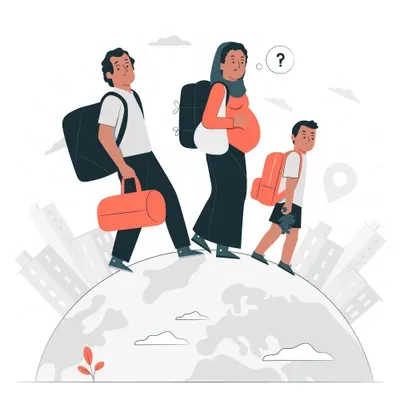
Migration Part 3 - At the border
61 other teachers use this template
Subjects
Migration Part 3 - At the border

You are at the border. Answer the border official's questions.
Stop the audio after each question.
Answer the questions of the border officer.
Put yourself in the immigrant's shoes
Border Rejections: Statistics and Implications
Overview
Immigration to the United States has been a complex and evolving issue, with policies and practices changing over centuries. The reasons for rejecting entry at the border are diverse, ranging from legal violations to health concerns, and the consequences of such rejections can significantly impact individuals and families.
Historical Context
The history of immigration to the United States is marked by various waves and policies aimed at controlling the flow of people into the country. From the colonial era to modern times, the U.S. has experienced significant immigration, with policies often reflecting the socio-political climate of the period.
Reasons for Rejection at the Border
Legal Violations
- Illegal Entry: Attempting to enter the U.S. without proper documentation or through unauthorized entry points.
- Visa Overstay: Staying in the U.S. beyond the period permitted by a visa.
- Criminal Record: Having a history of criminal activities either in the home country or elsewhere.
Health Concerns
- Contagious Diseases: Carrying diseases that could pose a public health risk.
- Medical Fitness: Failing to meet the health standards required for entry.
Security Threats
- Terrorism Links: Suspected involvement in terrorist activities.
- Smuggling: Involvement in human trafficking or drug smuggling.
Statistics on Border Rejections
Between 2010 and 2020, border rejections have varied, influenced by changes in immigration policies and enforcement practices. For example, in 2018, the U.S. Customs and Border Protection (CBP) reported over 300,000 rejections at various entry points.
Visa Overstay vs. Illegal Entry
From 2007 to 2018, visa overstays accounted for a larger share of the growth in the illegal immigrant population compared to illegal border crossings. By 2022, only 37% of illegal immigrants were from Mexico, indicating a shift in the demographics of those attempting to enter the U.S. illegally.
Consequences of Border Rejections
Immediate Consequences
- Detention: Individuals may be detained at the border pending further investigation.
- Deportation: Immediate return to the country of origin.
- Legal Proceedings: Facing legal actions for attempting illegal entry.
Long-term Implications
- Ban on Re-entry: Depending on the severity of the violation, individuals may face a ban on re-entry to the U.S. for several years.
- Economic Impact: Loss of potential employment and economic opportunities in the U.S.
- Family Separation: Families may be separated, with some members allowed entry while others are rejected.
Policy Implications
Enforcement and Challenges
- Increased Border Patrol: Strengthening border patrols and using technology to monitor and control illegal entry.
- Legal Reforms: Implementing comprehensive immigration reforms to address the root causes of illegal immigration and streamline the legal immigration process.
Humanitarian Concerns
- Asylum Seekers: Ensuring that genuine asylum seekers are given a fair chance to present their cases.
- Children and Families: Special considerations for families and unaccompanied minors to prevent undue hardship and trauma.
Conclusion
Border rejections are a critical aspect of U.S. immigration policy, reflecting the balance between national security and humanitarian concerns. Understanding the reasons and consequences of these rejections helps in shaping policies that are both effective and compassionate.
Sources:
